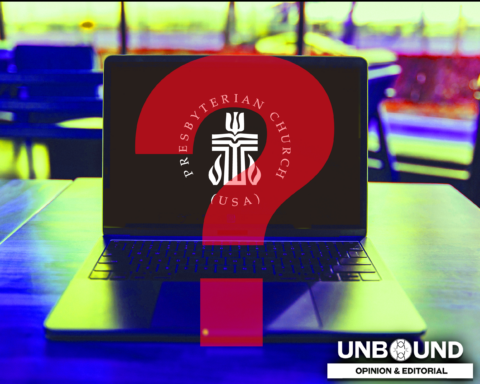Ark of Escape or Community of Reconciliation?
When I teach the Reformed Confessions to students at Union Presbyterian Seminary, I like to point out that one of the benefits of belonging to our communion is belonging to a tradition with a dynamic understanding of confessionalism. Unlike the Lutheran tradition, which closed its Book of Concord in 1580, at the 50th anniversary of the first presentation of the Augsburg Confession, the Reformed tradition decided to remain open to the possibility of, indeed the need for, new confessions in new times and places.
Because of our openness to new confessions, we have many, many more confessions than do the Lutherans; we also find ourselves with the sometimes-awkward situation of having to recognize the conflicts or inner contradictions between our various confessions. While there is certainly family resemblance that holds them all together in a recognizable unity, there can sometimes be sharp differences between confessions on individual points of doctrine, even to the point of complete reversals of opinion. We are not unfamiliar with this in our own Book of Confessions. Whereas the Scots Confession explicitly excludes women from the exercise of ministry (3.22), the Brief Statement of Faith says that the Holy Spirit calls women and men to all ministries of the church (10.4).
___________________________________________
Although it may not be noted as regularly as the change regarding women’s ordination, a similar 180-degree turn occurs in the theology of our confessions in the area of ecclesiology – our understanding of what it means to be the church.
___________________________________________
Although it may not be noted as regularly as the change regarding women’s ordination, a similar 180-degree turn occurs in the theology of our confessions in the area of ecclesiology – our understanding of what it means to be the church. It is most obvious if one compares the confessions written prior to the 20th century and those written after the turn of that century.
 To summarize briefly: our earliest confessions embrace Cyprian of Carthage’s view that the church is like Noah’s Ark – the true refuge whereby those whom God chooses will be saved from the coming damnation. Our more recent confessions return to an earlier biblical model, set out in both the Old Testament and the New Testament, in which the covenant people of God are given the mission to bear witness to the identity of the true God’s saving purpose for the world through their lives of justice-making (either through faithful obedience to Torah or through grateful response in obedience to the grace of God in Jesus Christ). The whole purpose of the life of the people of God, in this second model, is not to escape from a coming damnation, but to serve a coming reconciliation and redemption.
To summarize briefly: our earliest confessions embrace Cyprian of Carthage’s view that the church is like Noah’s Ark – the true refuge whereby those whom God chooses will be saved from the coming damnation. Our more recent confessions return to an earlier biblical model, set out in both the Old Testament and the New Testament, in which the covenant people of God are given the mission to bear witness to the identity of the true God’s saving purpose for the world through their lives of justice-making (either through faithful obedience to Torah or through grateful response in obedience to the grace of God in Jesus Christ). The whole purpose of the life of the people of God, in this second model, is not to escape from a coming damnation, but to serve a coming reconciliation and redemption.
To give a little evidence for these claims, let me begin with the Cyprianic Noah’s Ark ecclesiology. This kind of ecclesiology reigned supreme through most of Western Christian history. It is no particular fault of the Protestant Reformers that they followed in this line – they could hardly be expected to think differently than every other Christian of their time. Cyprian, in his treatise On the Unity of the Catholic Church (ca. 250 CE) had established the principle that “outside the church there is no salvation.” Several of our confessions in the Book of Confessions explicitly affirm this principle (Scots, 3.16; Second Helvetic, 5.136; Westminster Confession was edited somewhat on this point, 6.141).
___________________________________________
The older confessions have an ecclesiology that is focused inward. The church’s task is to save the folks that are inside of it.
___________________________________________
Because the church’s role is to serve as the vessel of escape from damnation, you want to make sure you are getting on board the right boat! For that reason, a lot of the ecclesiology of the ancient creeds and the classical Reformed confessions is taken up with the task of rightly identifying the church. The question, in other words, is: how can I be sure this is the true church? So you will find descriptions of the notes of the church in the Apostles Creed and the Nicene Creed (1.3, 2.3), and of the “marks” of the church that were added by the Reformers of the 16th century (the true preaching of the Word, the proper administration of the sacraments according to Christ’s command, and the exercise of discipline) (Scots, 3.18; Second Helvetic Confession, 5.134-5.135).
The Westminster Confession heavily emphasizes the invisibility of the true church, which consists only of those whom God has predestined for salvation. The visible or institutional church is not identical with this invisible body. It is, instead, a mixed bag of believers and unbelievers who are for a time going through some motions together but will be finally sorted out by God at a last judgment. The emphasis for what the church’s task is, though, still falls on the “gathering and perfecting of the saints” (Westminster Confession, 6.142).
The older confessions, then, have an ecclesiology that is focused inward. The church’s task is to save the folks that are inside of it. That said, it is all right to get more people inside the boat! If there is a mission emphasis in these earlier confessions, it would be framed in that way explicitly: invite others to get on board the ark before the disaster strikes. And make sure they are getting on board the right ark, as it were. The “mission” is to invite membership in the church by confession of belief, because “outside the church there is no salvation.”
___________________________________________
Does this mean that prior to the twentieth century the Reformed churches had no social conscience? By no means!
___________________________________________
Does this mean that prior to the twentieth century the Reformed churches had no social conscience? By no means! One needs only to read about the program of care of political refugees in Calvin’s Geneva to know that this was not the case. If we look for evidence in the Book of Confessions, I think the most interesting case can be made from the section of the Westminster Larger Catechism on the Ten Commandments (7.201-7.261). Particularly when one looks at what the catechism thinks is obliged rather than what is forbidden by a particular commandment, the possible program of social justice that is laid out for Presbyterian believers can be daunting.
For example, the sixth commandment – ‘Thou shalt not kill’ – is not kept simply by avoiding outright murder. One must also preserve one’s own life and others’ lives by
“subduing all passions, and avoiding all occasions, temptations, and practices which tend to the unjust taking away the life of any; by just defense thereof against violence; patient bearing of the hand of God, quietness of mind, cheerfulness of spirit, a sober use of meat, drink, physic, sleep, labor, and recreation; by charitable thoughts, love, compassion, meekness, gentleness, kindness, peaceable, mild, and courteous speeches and behavior, forbearance, readiness to be reconciled…protecting and defending the innocent” (7.245).
There are ways one could read that list that would suggest involvement in all kinds of personal and communal programs for reform and justice, ranging from food justice to labor laws and fair housing to organizing against war, the use of torture, or the death penalty (and possibly even to following a healthy diet and exercise program!).
Fast-forward to the twentieth century. In truth, we owe much of the transformation in ecclesiology that we can observe in our confessions to the Second Vatican Council and the theological revolution that it set off in ecclesiology in the Roman Catholic Church. The Dogmatic Constitution on the Church Lumen Gentium, promulgated by Pope Paul VI in 1964, sounded many similar notes to those I want to draw out from our Confession of 1967, including the importance of laypeople in the ministry of the church, the church’s role as God’s agent of reconciliation in the world, and the ways in which justice-making specifically has an evangelistic or mission-oriented purpose.
___________________________________________
So what does this new emphasis in ecclesiology look like? As I stated in the beginning of the article, it is actually the recovery of an older biblical model.
___________________________________________
So what does this new emphasis in ecclesiology look like? As I stated in the beginning of the article, it is actually the recovery of an older biblical model. The Apostle Paul specifically saw the church as the continuation of the people of Israel. Like the people of God in the old covenant, the church is called by God to be a people set apart for a purpose. God promised Abraham that through him all the nations of the earth would be blessed, and the people of the old covenant were the witnesses to this special grace of God through their faithfulness to the covenant under life ruled by Torah.
In Jesus Christ, Paul argued, the promise comes to fulfillment, for God was in Christ reconciling the world to Godself, not counting their trespasses against them and entrusting the church with the message of reconciliation. It is the mission of the church to be ambassadors of reconciliation, the witnesses to a gift – a reconciliation that is reaching out to the entire world from God through Jesus Christ (2 Cor.5:18-20). The church now carries out this mission through its new life “in the Spirit” ruled by “the mind of Christ” (Gal. 5:16-24; 1 Cor. 2:6-14; Phil. 2:5-8).
The confession in our Book of Confessions that frames itself explicitly in these Pauline terms is the Confession of 1967. It is significantly structured both by the “apostolic blessing” of II Cor. 13:14 and according to the vision of God’s reconciling work in Jesus Christ and the church’s subsequent ministry of being ambassadors of reconciliation from II Cor. 5:16-21. The section on ecclesiology starts out with, using today’s buzzwords, what we might call a “missional” definition of the church: “This community…is entrusted with God’s message of reconciliation and shares his labor of healing the enmities which separate men from God and from each other…. The church maintains continuity with the apostles and with Israel by faithful obedience to his call” (9.31). Although the church gathers to worship and be renewed, it also regularly “disperses to serve God wherever its members are, at work or play, in private or in the life of society…. Their witness is the church’s evangelism. Their daily action in the world is the church in mission to the world. The quality of their relation with other persons is the measure of the church’s fidelity” (9.37).
___________________________________________
If we take The Confession of 1967 seriously, a church that is only gathering for worship on Sunday mornings and Bible study on Wednesday evenings is hardly a church!
___________________________________________
The confession mentions many specific issues to be addressed by the church’s mission, including poverty, ecological destruction, sexuality and the relationships between persons so entailed, employment, housing, education, family, racial discrimination, nationalism, technology, and so on (9.43-9.47). Although it deals with preaching and sacraments, these are no longer treated as “marks” for identifying the true church, but rather as “equipment” for building up the people of God for doing the work of witness in the world (9.48-9.52). If we take The Confession of 1967 seriously, a church that is only gathering for worship on Sunday mornings and Bible study on Wednesday evenings is hardly a church!
The most important identifier of the church in the 20th century confessions is faithful witness. In the words of another 20th century confession, the Barmen Declaration: “As Jesus Christ is God’s assurance of the forgiveness of all our sins, so in the same way and with the same seriousness is he also God’s mighty claim upon our whole life. Through him befalls us a joyful deliverance from the godless fetters of this world for a free, grateful service to his creatures” (8.14). This is nothing less than a summons to mission!
*****
AUTHOR BIO: Dawn DeVries has served on the faculty of now Union Presbyterian Seminary since 1995, and since 1999 has been the John Newton Thomas Professor of Systematic Theology. Prior to that she served on the faculties of San Francisco Theological Seminary and McCormick Theological Seminary. She received her Ph.D. from the University of Chicago. DeVries’ scholarship includes the history of doctrine and Reformed theology. The recipient of numerous academic honors, she was named a Henry Luce III Fellow in Theology for 1997-1998. She was a delegate for the Presbyterian Church (U.S.A.) to the 8th Assembly of the World Council of Churches and serves as an official delegate of the World Alliance of Reformed Churches to the International Eastern Orthodox/Reformed Dialogue. She served on the PC(USA) Special Committee on Catechism, and more recently on the Special Committee on a Translation of the Heidelberg Catechism. She is author of Jesus Christ in the Preaching of Calvin and Schleiermacher.






Unbound Social